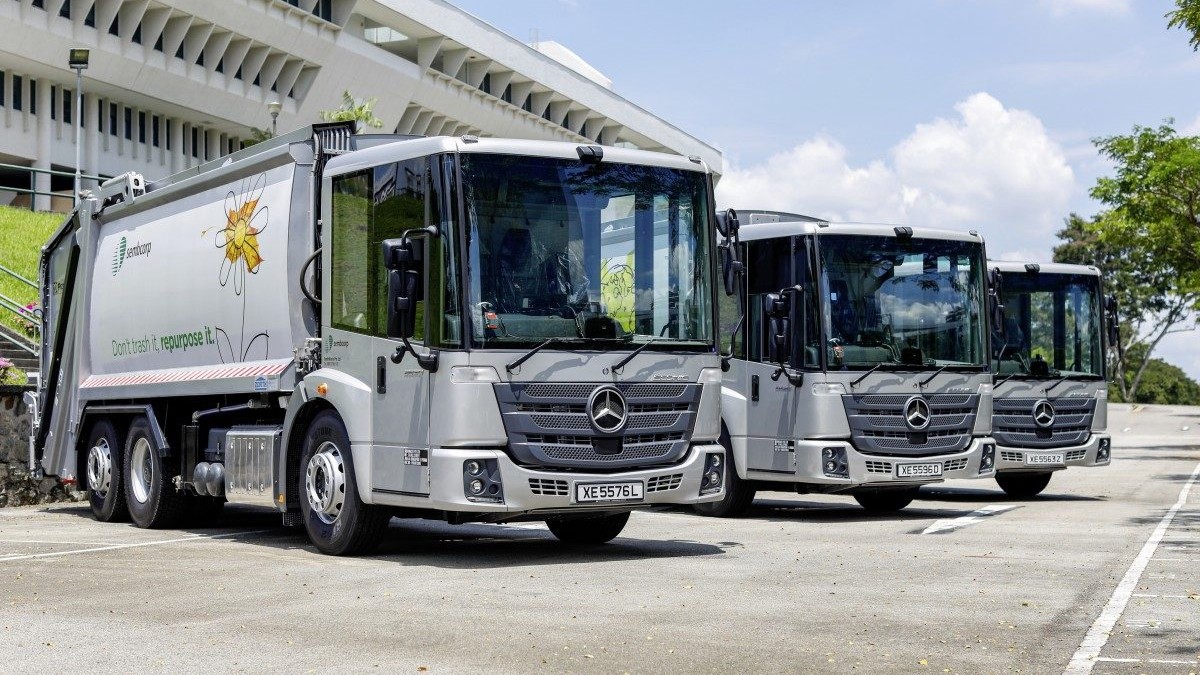The Mercedes-Benz Econic turns 25

The Econic was presented for the first time in 1998 at the Entsorga trade fair, and has since been continuously expanding its urban operations in Europe and overseas.
Its range of applications extends from municipal use as a waste collection and disposal vehicle to city delivery operations and as an emergency vehicle for fire departments and road construction projects.
In 2001, the Econic family was expanded to include a 6×4 variant, to which the Econic 8×4/4 with four-wheel steer and four-wheel drive was added in 2004.
The Econic with a natural gas engine was introduced in 2002. The following year, production was relocated to the current Econic site in Wörth. The 5000th Econic rolled off the production line there in 2005.
Around 28,000 Econic trucks have been built and delivered to date.
In 2009, more than 1500 Econic vehicles were delivered for the first time within one year, and two years later a total of 10,000 Econic vehicles was exceeded. This was followed in 2013 by the world premiere and the start of series production of the new Econic generation, whose basic components are still in use today.
A further milestone was reached in 2022 for sustainability goals: The all-electric eEconic has been added to the conventional Econic in the product range.
Around 28,000 Econic trucks have been built and delivered to date. Of these, around 85 percent are used for waste disposal and around five percent are used by fire brigade. A further 10 percent are used for other operations, as dump trucks or cement mixers, for example, for road construction or as refueling or catering vehicles at airports.
The latest generation of the Econic with Euro VI diesel technology
Today’s Econic is available as a two-, three- or four-axle vehicle with a permissible gross mass of 18, 26 and 32 tonnes. It is available with a low or high cab, wheelbases from 3450 to 5700mm and engine outputs from 200kW (272hp) to 260kW (354hp).
In addition to the tried-and-tested Allison torque-converter automatic transmission with six gears, the Econic can, as an option, also be equipped with the fuel-efficient Mercedes-Benz PowerShift 3 automatic transmission with 12 forward and four reverse gears, which has specially adapted drive programmes for urban traffic.
In Australia and New Zealand, the Econic Dual Control meets the requirements of local municipal waste disposal companies with two fixed steering columns and two steering wheels. Therefore the driver can always sit on the right side in order to keep an eye on the work of the side loader waste collection system.
Environmentally friendly on the road for two decades thanks with a natural gas engine
Although the Econic has been available with a natural gas engine since 2002, the Econic NGT (Natural Gas Technology) could increase its environmental compatibility from March 2015 on.
The CO2 emissions of the drive system with compressed natural gas (CNG) are up to 20 percent lower than those of its diesel counterpart.
Using renewable biogas has further improved the CO2 footprint of the Econic NGT. The performance of the six-cylinder in-line natural gas engine M 936 G with 222kW (302hp) from a displacement of 7.7L achieved the values of a comparable diesel engine.
Around ten percent of the Econic vehicles sold feature the environmentally friendly NGT drive. In 2022, the Econic NGT stepped aside to allow production of the battery-electric eEconic.
The battery-electric eEconic is on its way
Since the start of series production in autumn 2022, the Mercedes-Benz eEconic has also been available as a variant with a battery-electric drive.
Mercedes-Benz Special Trucks is thereby expanding its range by a locally CO2-neutral and low-noise vehicle for municipal services with frequent stop-and-go operations. Due to frequent braking in inner-city traffic, the eEconic can make good use from recuperation.
The eEconic has an e-axis with an integral drive unit and two electric motors. Due to three battery packs with a capacity of 336kWh, a single battery charge is usually sufficient to cover all daily inner-city routes in one shift. The vehicle can be charged with up to 160kW overnight at the depot. This protects the batteries and allows using cheaper electricity rates.
Tried-and-tested features have also been preserved in the fully electric eEconic. The wide view of the traffic thanks to the large, heated thermocontrol windscreen, the convenience of getting in and out thanks to the low-entry design, the availability of efficient assistance systems and the maneuverability, even with heavy loads, help to increase safety for the driving personnel at work and other road users.
Thanks to the eEconic’s electrical driveline, the cab floor has been designed to be level, which makes it easier to climb through the cab and reach the side facing away from the traffic.
Special cab and assistance systems increase safety
Combined with the driver’s low seating position, which puts him at eye level with other road users, the generous glazing of the Econic cabs enables direct eye contact and a forward-looking assessment of the surrounding traffic. This increases road safety when turning off, at junctions and when road works are taking place on the roadside.
A comprehensive package with up to ten safety assistance systems helps drivers using the latest generation of vehicles to maintain an overall view, even in critical situations. The Econic and eEconic already feature extensive safety and assistance systems as standard, such as Active Brake Assist 5 with pedestrian detection, the Lane Keeping Assist and a rain and light sensor.





